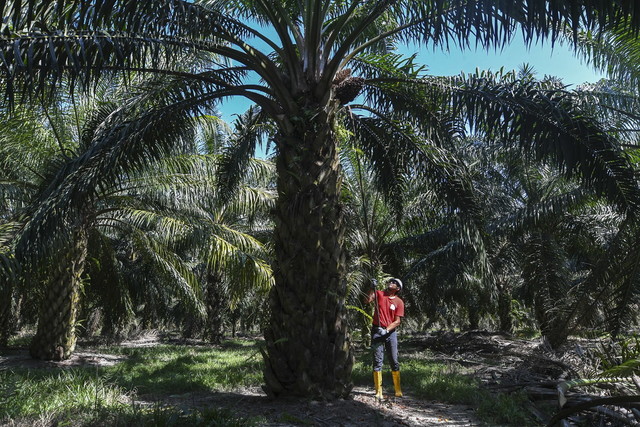By Nurqalby Mohd Reda
KUALA LUMPUR, Jan 25 (NNN-Bernama) – It is one thing to be a leading producer of palm oil but it is quite another thing to be a huge producer of oil palm waste which, if not managed sustainably, can be detrimental to the environment.
Malaysia is the second-largest producer of palm oil in the world after Indonesia and its palm oil exports are expected to increase by 3.7 percent to 16.30 million tonnes this year due to higher demand from palm oil importing countries such as the United Arab Emirates, Saudi Arabia, Japan, Bangladesh and Egypt.
In terms of the waste generated by the commodity, the palm oil industry accounts for 85 percent of the 96 million tonnes of biomass waste created by Malaysia’s agricultural sector every year. Experts are, naturally, concerned about the figures as oil palm biomass can have a negative impact on the environment if they are left to decompose in landfills.
OIL PALM WASTE POTENTIAL
To help address this issue, a team of researchers from Universiti Malaya, led by lecturer Associate Prof Dr Shaifulazuar Rozali from the Department of Mechanical Engineering, Faculty of Engineering, is currently carrying out a study to seek cost-effective ways of converting oil palm waste into value-added carbon-based materials that can be used for various applications.
Major oil palm waste comprises palm kernel shells, empty fruit bunches and oil palm fronds.
“Oil palm is mainly used to produce palm oil and the waste is used as animal feed or turned into organic fertiliser. The rest of it (waste) is left to decompose.
“However, the decaying oil palm materials will change into biomass capable of producing harmful greenhouse gases including methane, as well as leachates that can also pollute the environment,” Shaifulazuar told Bernama.
He said through their study, which started in 2019, his team hopes to convert oil palm waste into products that can be used in daily life, which is in line with government policies promoting efforts to convert biomass waste into value-added products.
“Through our research, we found that oil palm waste such as empty fruit bunches and palm fronds or those that have decomposed into biomass can be converted into high-value carbon that possesses the characteristics of activated carbon as well as nanocarbon which are more environmentally friendly,” he explained.
According to Shaifulazuar, among the carbon-based materials that can be produced from oil palm waste are activated carbon, biochar, graphene, carbon nanotube, carbon fibre, magnetic nanocarbon and carbon nanospheres that are used in the production of various goods such as batteries, transistors, sensors, water and air filters, optical communication materials and aerospace components.
“In our research, we are focusing on the production of activated carbon, biochar and nanocarbon for which we are also developing a new processing technology that is faster and costs less compared to (findings of) existing studies done previously,” he said.
Shaifulazuar and his team have so far covered 60 percent of their study and are confident of completing it in the next three years depending on the availability of funds.
He said their study was initiated with funds from the Ministry of Higher Education, however, the team is now in need of additional funding to continue the project.
GOOD PROSPECTS IN GLOBAL MARKET
Shaifulazuar also said that high-value carbon-based products have in recent times gained a place in the global market as carbon is one of the basic materials used in the manufacturing of electronic devices.
“For instance, a report in marketsandmarkets.com showed that the demand for carbon nanotubes was worth US$876 million in 2021 and the value is expected to escalate to US$1.7 billion before 2026.
“Fortune Business Insight, meanwhile, expects demand for grapheme to swell from US$337 million in 2022 to US$2.17 billion in 2029,” he said.
However, one of the drawbacks of unlocking the potential of oil palm waste is the high cost of extracting carbon from biomass.
“The production cost of each kilogramme of nanocarbon, for example, can reach RM5,000. This (cost) can curb the demand for this particular type of carbon.
“This is why our research team’s objective is to seek effective ways of producing this carbon (nanocarbon) at a lower cost. If we are able to realise this, Malaysia will surely be capable of becoming a major producer of nanocarbon in future,” he added.
Shaifulazuar also said that although Malaysia is currently a producer of activated carbon, the quantity produced is small compared to the size of the global market. Its production of nanocarbon, meanwhile, is currently only at the laboratory scale.
In its 12th Malaysia Plan (2021-2025), the government introduced a comprehensive National Energy Policy to provide a long-term strategic direction supporting the nation’s aspirations to become a carbon-neutral nation.
Under the plan, renewable energy generation from solar, biomass and biogas sources is targeted to increase to 31 percent of total installed capacity by 2025.
The circular economic model will also be implemented under the 12th Malaysia Plan to reduce pollution, waste generation and reliance on natural resources.
— NNN-BERNAMA





